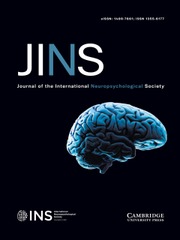Crossref Citations
This article has been cited by the following publications. This list is generated based on data provided by
Crossref.
Grady, Cheryl
2012.
The cognitive neuroscience of ageing.
Nature Reviews Neuroscience,
Vol. 13,
Issue. 7,
p.
491.
Suk, Heung-Il
Wee, Chong-Yaw
and
Shen, Dinggang
2013.
Machine Learning in Medical Imaging.
Vol. 8184,
Issue. ,
p.
131.
Li, YaPeng
Qin, Yuanyuan
Chen, Xi
Li, Wei
and
Forloni, Gianluigi
2013.
Exploring the Functional Brain Network of Alzheimer’s Disease: Based on the Computational Experiment.
PLoS ONE,
Vol. 8,
Issue. 9,
p.
e73186.
Vaidya, Chandan J.
and
Gordon, Evan M.
2013.
Phenotypic Variability in Resting-State Functional Connectivity: Current Status.
Brain Connectivity,
Vol. 3,
Issue. 2,
p.
99.
Biao Jie
Daoqiang Zhang
Wei Gao
Qian Wang
Chong-Yaw Wee
and
Dinggang Shen
2014.
Integration of Network Topological and Connectivity Properties for Neuroimaging Classification.
IEEE Transactions on Biomedical Engineering,
Vol. 61,
Issue. 2,
p.
576.
Carlozzi, Noelle E.
Tulsky, David S.
Chiaravalloti, Nancy D.
Beaumont, Jennifer L.
Weintraub, Sandra
Conway, Kevin
and
Gershon, Richard C.
2014.
NIH Toolbox Cognitive Battery (NIHTB-CB): The NIHTB Pattern Comparison Processing Speed Test.
Journal of the International Neuropsychological Society,
Vol. 20,
Issue. 6,
p.
630.
Li, Yang
Wee, Chong-Yaw
Jie, Biao
Peng, Ziwen
and
Shen, Dinggang
2014.
Sparse Multivariate Autoregressive Modeling for Mild Cognitive Impairment Classification.
Neuroinformatics,
Vol. 12,
Issue. 3,
p.
455.
Frantzidis, Christos A.
Ladas, Aristea-Kiriaki I.
Vivas, Ana B.
Tsolaki, Magda
and
Bamidis, Panagiotis D.
2014.
Cognitive and physical training for the elderly: Evaluating outcome efficacy by means of neurophysiological synchronization.
International Journal of Psychophysiology,
Vol. 93,
Issue. 1,
p.
1.
Zakzanis, Konstantine K.
and
Azarbehi, Rostam
2014.
Introducing BRAINscreen: Web-Based Real-Time Examination and Interpretation of Cognitive Function.
Applied Neuropsychology: Adult,
Vol. 21,
Issue. 2,
p.
77.
McAndrews, Mary Pat
2014.
Memory Assessment in the Clinical Context Using Functional Magnetic Resonance Imaging.
Neuroimaging Clinics of North America,
Vol. 24,
Issue. 4,
p.
585.
Han, S. Duke
Boyle, Patricia A.
Yu, Lei
Fleischman, Debra A.
Arfanakis, Konstantinos
Leurgans, Sue
and
Bennett, David A.
2014.
Financial literacy is associated with medial brain region functional connectivity in old age.
Archives of Gerontology and Geriatrics,
Vol. 59,
Issue. 2,
p.
429.
Meusel, Liesel-Ann C.
Kansal, Nisha
Tchistiakova, Ekaterina
Yuen, William
MacIntosh, Bradley J.
Greenwood, Carol E.
and
Anderson, Nicole D.
2014.
A systematic review of type 2 diabetes mellitus and hypertension in imaging studies of cognitive aging: time to establish new norms.
Frontiers in Aging Neuroscience,
Vol. 6,
Issue. ,
Farràs-Permanyer, Laia
Guàrdia-Olmos, Joan
and
Peró-Cebollero, Maribel
2015.
Mild cognitive impairment and fMRI studies of brain functional connectivity: the state of the art.
Frontiers in Psychology,
Vol. 6,
Issue. ,
Han, S. Duke
Boyle, Patricia A.
James, Bryan D.
Yu, Lei
Bennett, David A.
and
Libon, David
2015.
Mild Cognitive Impairment and Susceptibility to Scams in Old Age.
Journal of Alzheimer's Disease,
Vol. 49,
Issue. 3,
p.
845.
Suk, Heung-Il
Wee, Chong-Yaw
Lee, Seong-Whan
and
Shen, Dinggang
2015.
Supervised Discriminative Group Sparse Representation for Mild Cognitive Impairment Diagnosis.
Neuroinformatics,
Vol. 13,
Issue. 3,
p.
277.
Han, S. Duke
Boyle, Patricia A.
James, Bryan D.
Yu, Lei
and
Bennett, David A.
2015.
Mild Cognitive Impairment Is Associated with Poorer Decision‐Making in Community‐Based Older Persons.
Journal of the American Geriatrics Society,
Vol. 63,
Issue. 4,
p.
676.
Han, S. Duke
Boyle, Patricia A.
James, Bryan D.
Yu, Lei
and
Bennett, David A.
2015.
Poorer Financial and Health Literacy Among Community-Dwelling Older Adults With Mild Cognitive Impairment.
Journal of Aging and Health,
Vol. 27,
Issue. 6,
p.
1105.
Ren, Ping
Lo, Raymond Y.
Chapman, Benjamin P.
Mapstone, Mark
Porsteinsson, Anton
and
Lin, Feng
2016.
Longitudinal Alteration of Intrinsic Brain Activity in the Striatum in Mild Cognitive Impairment.
Journal of Alzheimer's Disease,
Vol. 54,
Issue. 1,
p.
69.
Wee, Chong-Yaw
Yang, Sen
Yap, Pew-Thian
and
Shen, Dinggang
2016.
Sparse temporally dynamic resting-state functional connectivity networks for early MCI identification.
Brain Imaging and Behavior,
Vol. 10,
Issue. 2,
p.
342.
De Marco, Matteo
Meneghello, Francesca
Duzzi, Davide
Rigon, Jessica
Pilosio, Cristina
and
Venneri, Annalena
2016.
Cognitive stimulation of the default-mode network modulates functional connectivity in healthy aging.
Brain Research Bulletin,
Vol. 121,
Issue. ,
p.
26.




